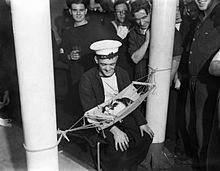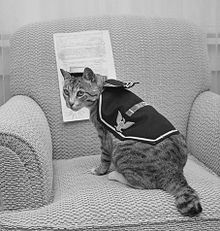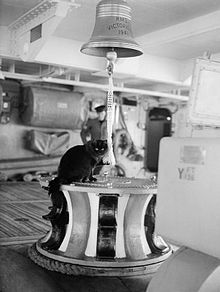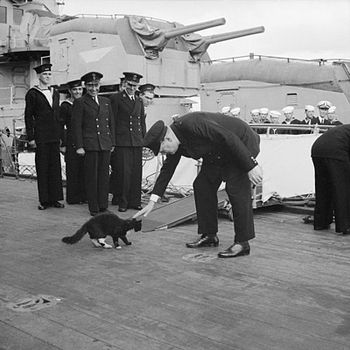Here is the long awaited (okay maybe only since I first mentioned it on Sunday) Thanksgiving card from Playful Kitty. We wish you all a very happy Thanksgiving. If you would like to make your own cards (Christmas is coming up) please visit my tutorial Tutorial & Freebies – Sending Kitty Christmas Cards . I will be glad to personally walk anyone through it who needs help.
Tag Archives: Thanksgiving
Cats in History: The Ship’s Cat & Mayflower II
Ahoy kitties! Believe it or not, cats have been an important part of nautical travel since the days of the Ancient Egyptians. The tradition of having a cat aboard began with the ancient Egyptians who used cats to help them hunt birds on their river rafts. Cats were not really thought of as “pets” , but rather as helper animals that served a specific purpose.
Later, as ships became larger and trips became longer, ship’s cats became even more important. Even the ancient sailors knew that cats are very efficient killers of rodents and other vermin. Mice and rats were more than just a nuisance on board a ship – they could sabotage an entire journey. Here are 3 good reasons they needed to have a good mousing cat aboard their ships:
-
Rodents would chew through ropes, sails, and other important ship components. Anyone who has had these pesky rodents get into their attic or garage knows that they will eat through anything. If a rat chewed through a rope significantly enough, then a sail may not be able to be properly raised or moved. Considering that sails were a ship’s only means of being propelled forward, being unable to raise a sail could be a big problem.
- Rodents could chew their way into food rations which could not be replenished at sea. Keeping the rodent population to a minimum could mean the difference between proper nutrition and starvation.
- Rodents (and their fleas) were known carriers of deadly diseases. As an example, the Boubonic plague was spread by rat fleas. On a ship where everyone lives in tight quarters for weeks to months on end, disease could spread quickly among the sailors.
Superstitions developed among sailors regarding the ship’s cat. Many believed that cats could predict the weather. The belief was that if a cat meowed, bad weather was on its way. Messing with the ship’s cat could also bring bad weather. If a cat was thrown overboard or lock in a cupboard, a storm was about to hit. Storms were dreaded by sailors as they could lead to devastating damages to the ship and crew. On the upside, it was believed that having a cat aboard was good luck.
The use of cats on ships is regarded as one of the ways domestic cats were spread around the world. Phoenician cargo ships brought the first domesticated cats to Europe around 900 B.C. As cats spread throughout the world, sailors would adopt foreign cats both as souvenirs and to remind them of the pets they left behind at home.
Somewhere around the end of World War II the tradition of ship cats dwindled off. The British Royal Navy banned cats from ships based on hygiene issues in 1975. Before the tradition came to its end there were a number of famous ship’s cats who bravely did their duty. There were several just during World War II alone: Blackie aboard the HMS Prince of Whales who was famous for greeting Winston Churchill, Convoy aboard the HMS Hermoine, Tiddles who was aboard several different Royal Navy aircraft carriers, Pooli aboard a U.S. attack transport, and surely many more.
The Mayflower
The original Mayflower’s journey began in England in 1620. There were 102 passengers aboard who were seeking employment and religious freedom. It isn’t known for sure whether or not there were any cats on the Mayflower, but it is assumed that there were because of the traditions held by sailors at the time. After 66 grueling days at sea averaging only 2 miles per hour, the Mayflower reached modern day Cape Cod, Massachusetts. The pilgrims lived through the winter on the Mayflower while they tried to build homes on the land. Only 53 passengers and half of the crew survived until spring time. The surviving crew took the Mayflower back to England and the surviving pilgrims began the colonies that would become the basis for the United States. No one knows what happened to the Mayflower after 1624. People in the U.S. celebrate Thanksgiving to commemorate the help the pilgrims had in surviving that first winter.
The Mayflower II
In the 1950’s England decided to commemorate the solidarity between the Americans and the British by recreating the Mayflower and its journey. From the original Mayflower blueprints, the Mayflower II was handcrafted in the same way the original would have been. The only changes in the design were a modern staircase between the main and lower decks, electric lighting, and a few other minor changes to accommodate tourists who would later visit the ship. The ship had no motor, it was propelled by the wind in its sails.
The Mayflower II set sail in 1957 with a crew of 34 – including the ship’s cat! A little black and white kitten named Felix was brought aboard the only American member of the crew. At first they weren’t sure that the kitten would survive. Even cats take a while to get their sea legs! His fur was matted and he was quite the mess. One day one of the sailors decided to bathe Felix and that was the turning point in his journey. After a little meow, Felix decided he was going to make it and grew strong and healthy from then on. He did have one little accident early on where a sailor accidentally stepped on him and broke his leg, but he healed up very nicely. The sailors took well to Felix and even made him his own life-jacket (which made Felix “semi-mutinous”). Arriving in Cape Cod 2 months after the beginning of the voyage, Felix was quite the celebrity. The Mayflower II is still in Plymouth, Massachusetts with plenty of Felix memorabilia.
Funny Cat Pictures: A Kitty Thanksgiving
For Playful Kitty’s first Thanksgiving we did a greeting card campaign thanking all of the local cat rescues (some of them rescue dogs and other animals as well) for all that they do. Cinco and Manna participated by giving us a great photo to send in the card. I will show you the card a little later in the week. Nothing beats dressing the set with catnip!
“My Cat Ate What?”; Help for Poisoned Pets
With the holidays just around the corner and there are more and more potential poison hazards for our cats in our homes. The decorations are going up, food is being prepared for festive feasting, and preparations are being made for the winter’s grand entrance. Without a doubt the cat has noticed the festivity and all the new shinny things in its surroundings. Should your cat become too curious and decide to get into something it shouldn’t, it is good to know what to do.
Common Household Poisons
Many things that are completely harmless (when used correctly) for humans can send your cat on an emergency trip to the vet. You may have toxic objects around your house already. Products labeled “non-toxic” may be non-toxic to humans, but not necessarily to cats. Poisons can be ingested, absorbed through the skin, or inhaled. Here are a few household items that are poisonous to cats:
- Chocolate
- Coffee
- Alcoholic Beverages
- Grapes
- Garlic
- Onions
- Citronella Candles
- Liquid Potpourri
- Antifreeze (This seems like a no-brainer, but it tastes sweet to cats.)
- Human Medications (such as pain relievers, laxatives and antidepressants)
- Fabric Softener Sheets
- Batteries
- Christmas Tree Water (if you have a live tree)
- Glow Sticks
- Water-based Paint
- Tulip Bulbs (as well as other plant bulbs)
- Poinsettias
Visit the ASPCA Animal Poison Control site for a more extensive listing of toxic items. They have detailed lists of toxic plants and foods as well as a section that “sets the record straight” on a lot of items.
What Do I Do Now?
Okay, so you just saw your cat eat one of the grapes you had on a tray on the counter for your guests. What do you do?
- Remove the from the presence of the poison. You certainly don’t want your cat to just keep eating (or playing in) a poisonous substance.
- Observe the cat for any symptoms that it might display. You will need to be able to describe the symptoms to a veterinarian or a animal poison control specialist.
- Place a sample of the poisonous substance in a container that can go with you to the vet. Be sure to include any left over parts of the substance that your cat may have taken bites from. Take this sample even if you are familiar with the substance (i.e. chocolate, grapes, coffee, etc). Having this will help your veterinarian to positively identify the exact poison affecting your cat.
- If the cat has vomited, put as much of the vomit in a seal-able container as you can and bring that to the vet as well.
- Call your veterinarian and let them know your cat has been poisoned and you are on your way in for an emergency. Follow the veterinarian’s advice carefully; they may ask you to do some first aid at home before you come in. Take the cat in even if there are no symptoms. With some poisons, it can take hours or even days before symptoms begin to show up and it could be too late to do anything by then.
ASPCA Animal Poison Control
The ASPCA has the most extensive poison control for animals that is out there. You can call the ASPCA Animal Poison Control at (888) 426-4435 for help with any animal poisoning emergency. They are available 24 hours per day, 7 days per week, 365 days per year. There is a charge of $65 for the consultation. If your cat is having trouble breathing, having seizures, or loosing consciousness it is best to take them straight to your veterinarian’s office rather than calling animal poison control. If you do decide to call animal poison control they will need the following information:
- The type of animal you are calling for (species and breed) and the number of animals affected.
- The size and weight of the animal.
- Whether the animal is male or female.
- What symptoms your animal is displaying.
- Information on the poisonous substance involved. If it is available, they will want to know a product number for the substance.
- The length of time since the animal ingested/absorbed/inhaled the poisonous substance.
Keeping A First-Aid Kit Handy

ASPCA Animal First Aid Kit
When you talk to your veterinarian or ASPCA Animal Poison Control they may ask you to do some first aid on the cat. Follow their instructions very carefully. It doesn’t hurt to have a first-aid kit for your cat already prepared so those things are ready for use when you need them.
If you have a first aid kit for the humans in your house, many of the items will be the same; gauze dressings of various sizes, scissors, tweezers, hydrogen peroxide, saline eye solution, vinyl gloves, eye pad, triangular bandages, first-aid tape, antibiotic ointments, and antiseptic wipes. The items that would be more specific to cats are:
- Turkey baster or large bulb syringe
- Mild dish washing liquid
- Forceps
- A can of wet cat food
- The cat’s carrier
- Rectal thermometer
Getting a first-aid kit together isn’t very hard. The ASPCA sells a kit with some of the items listed above on their website. Another way to piece together your kit is to use Pet 360. Many of the first-aid products featured on Pet 360 are American made and there are some homeopathic options. Pictured below are a few of the first aid products on Pet 360. Click on the banner below to visit Pet 360.
- Vet Flex Bandaging Tape For Pets
- Four Paws Antiseptic Quick Blood Stopper Powder For Pets
- Ticked-Off Tick Remover Tool For Pets














